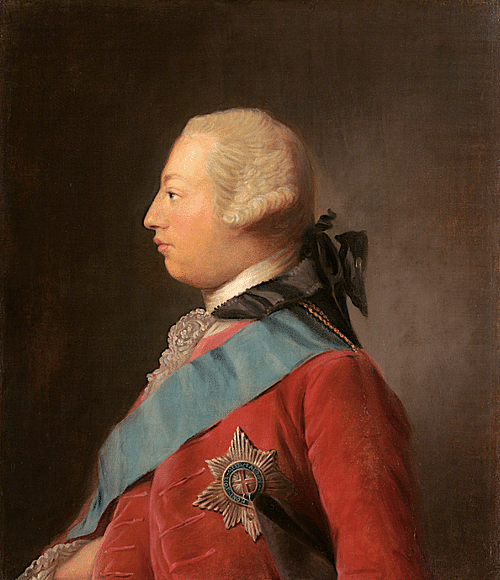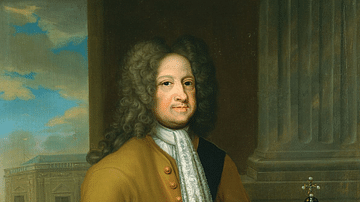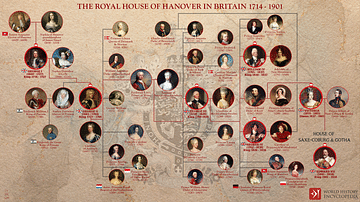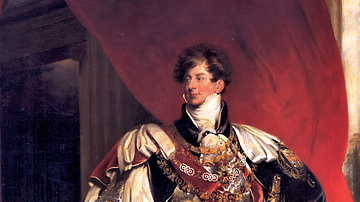
George III of Great Britain (r. 1760-1820) was the third of the Hanoverian monarchs, and he remains the longest-reigning king in British history. His six decades on the throne saw the creation of the United Kingdom, the loss of the 13 American colonies, but massive expansion of the British Empire elsewhere, and great victories such as Trafalgar against the French.
King George's Britain saw social changes with developments in agriculture and the first inventions of the British Industrial Revolution. The arts flourished, too, with the Georgian style of architecture sweeping across cities and the arrival of literary greats like Lord Byron and Sir Walter Scott. King George suffered from serious mental illness in the latter part of his life, and his son took over as Prince Regent in 1811 before succeeding him on his death as George IV of Great Britain (r. 1820-1830).
The House of Hanover
King George I of Great Britain (r. 1714-1727) became the first Hanoverian ruler in Britain in 1714 thanks to Queen Anne of Great Britain (r. 1702-1714) having no children. George was Elector of Hanover, a small principality in Germany, and the queen's nearest Protestant relative. He did have a remote connection to the royal Stuart line as he was a descendant of Elizabeth Stuart (d. 1662), daughter of James I of England (r. 1603-1625). George I was succeeded by his son, who became George II of Great Britain (r. 1727-1760). George II did not have a good relationship with his eldest son and heir Frederick Louis (b. 1707), but Frederick died nine years before his father in 1751 of pneumonia or a sporting accident. Frederick's eldest son George was then selected as the heir to the throne.
George William Frederick, future George III, was born on 4 June 1738 at Norfolk House in London. His father was Frederick, Prince of Wales, and his mother was Augusta of Saxe-Gotha (1719-1772). When Frederick died in 1751, George became the Prince of Wales. King George II died of a heart attack on 25 October 1760 in Kensington Palace. Prince George thus became king at the age of 23, and he also took on his grandfather's title of Elector of Hanover. George III's coronation was held on 22 September 1761 in Westminster Abbey. The young king was described by the duchess of Northumberland as tall, strong, with fair hair and blue eyes (Cannon, 324).
Family & Character
On 8 September 1761, George married Princess Charlotte of Mecklenburg-Strelitz (1744-1818) in St. James' Palace; it was the first day they had met. Unlike his predecessors in the Hanover family, George remained faithful to his wife and did not have any mistresses, although he was rather difficult in domestic life. The royal couple, who called each other Mr and Mrs King in private, had 15 children, several of which died in infancy; two of the sons would become kings: George (b. 1762) and William (b. 1765). The royal court was remarkably tranquil, with few lavish banquets, gambling frowned upon, and religious matters to the fore. The king always got up early, worked hard, and always ate in moderation. He liked painting and playing the harpsichord and flute. He was also rather more scholarly than his predecessors, taking an active interest in agriculture and writing on that subject under the pseudonym Ralph Robinson. He even ran a small farm for the benefit of his children, which earned him the nickname of 'Farmer George'.

The king actively collected books from a young age so that he eventually amassed a library of over 65,000 books. The king gave access to his library to scholars, and on his death, it was donated to the British Museum (today it is part of the British Library). Here was a new Hanoverian monarch, indeed. In 1762, unhappy with his other royal residences, the king moved to Buckingham House in London, which ultimately became Buckingham Palace. Two locations which did appeal to the royal family were Windsor Castle and Kew Gardens.
Unlike the previous Hanover monarchs, George spoke English as his first language, and he never visited the principality. The monarch never visited the corners of his realm either, with Scotland, Wales, Ireland, and the north of England never benefitting from a royal visit in his six-decade reign. Despite his inability to withdraw from southern England, the king viewed himself as the 'Patriot King', one who cared not for party politics but the ambition of the British Empire. The king, unlike his grandfather and great-grandfather, was able to trust the Tories again as his advisers. This party had been tainted in the past by its association with the rebel Jacobite cause, which tried to restore the Stuart royal line. Naturally, politicians belonging to the other main party, the Whigs, were not happy to see the end of their monopoly over the royal ear, even if they continued to win the general elections.
The Empire Grows
The Seven Years' War (1756-63) was a cross-European, intercontinental conflict, one which saw Britain and Prussia against Spain and France (and several other states). There were notable British losses early on, but a highlight was gaining control of Canada in 1760. Britain and Prussia finally won the war, with the former, in particular, benefiting from a reshuffle of colonies to gain dominance in the eastern side of North America, the Caribbean, and India.

King George commissioned the extraordinary navigator Captain James Cook (1728-79) to explore the Pacific Ocean. Cook was the first known European to chart the eastern coast of the Australian continent, landing in Botany Bay in April 1770, an area Cook named New South Wales. In another expedition, Cook became the first European to cross the Antarctic Circle in 1773 and prove once and for all that there was no great southern continent in temperate waters but very likely an icebound land further south.
The Indian subcontinent, where the hugely powerful East India Company was rapidly increasing its territories and revenues, looked the most promising corner of the empire in terms of potential revenues from taxes, trade, and the exploitation of natural resources. In June 1757, Robert Clive (1725-1774) masterminded victory at the Battle of Plassey and so won control of Bengal. Revenue from Bengal and a trade monopoly in India and with China paid for even larger armies and more wars. The East India Company won the four Anglo-Mysore Wars (1767-99) to gain territory in southern India. Victory in the three Anglo-Maratha Wars (1775-1819) gave control of central India. Victory in the Anglo-Nepalese War (1814-16) extended British India up to the Himalayas. Only the Punjab remained out of British control, and this was conquered by 1849. India became the Jewel in the Crown of the British Empire, especially so after the disaster of losing control of eastern North America.
The Loss of the American Colonies
The 13 British colonies on the eastern side of North America pushed for independence in the latter half of the 18th century. There were some 2 million people living in these colonies, and a great many of them believed George III was a despicable tyrant out to repress their freedom. George III makes for an unlikely tyrant as, in reality, he played the part of a back-seat constitutional monarch like no king or queen had ever done before him. The British government and its new breed of all-powerful prime ministers may have been the real enemy, but it was King George as the figurehead who became the target of hatred and propaganda.

The British regarded North America as an important source of trade goods like tobacco and a lucrative market in which to sell goods made in Britain and other parts of the empire. The British government was not quite sure how to handle the colonists' requests for greater political freedom since no other colony had ever done such a thing. The British error was not to realise that the wealth of the American colonies, the presence of a democratic assembly in each state, and the largely European makeup of their citizenry all combined to place them in a particular position. North America was not India and could not be treated as such. The Americans regarded themselves as equals to British citizens, but they had no political representation in the British parliament, which was imposing legislation on them. What the American citizens did have in common with their British counterparts was the obligation to pay taxes. "No taxation without representation" became the rallying cry of the colonials.
The situation worsened as taxes and port duties were raised in the 1760s, principally to help pay for the Seven Years' War (and the colonies had indeed benefited from the defeat of France in North America). In 1770, duties were abolished with the exception of tea, but the colonists were concerned over a proposal to offer the East India Company a monopoly on tea imports and showed their anger at the Boston Tea Party in 1773. In 1774, the most militant of the colonists got together at the Continental Congress in Philadelphia and proclaimed they would no longer tolerate the tyranny of British laws. The British government's misguided response was to use force. In 1775, the American Revolutionary War (aka War of Independence) broke out. The American army was ably led by George Washington (1732-1799). A formal Declaration of Independence was made on 4 July 1776. Britain's three main European rivals joined the Americans: France (1778), Spain (1779), and the Netherlands (1780). A major British defeat at Yorktown, Virginia, in October 1781 was a turning point, but in the longer term, it was the defeat to the French navy a few weeks before at the Battle of the Chesapeake that decided the war. Without hope of resupply by sea, the British armies in America were doomed.
On 3 September 1783, the British government ended the war and formally recognised the independence of the 13 colonies in the Treaty of Versailles. The crisis caused the king to seriously consider abdicating – he even drafted a speech to that effect – but there were other problems and opportunities to deal with elsewhere, and what became the United States, with George Washington as its first president, was written off as a terrible loss, but one that might be balanced by the gains in India and elsewhere. The British also retained control of Canada and the West Indies.

Ireland & Act of Union
At the close of the 18th century, the Irish were as keen to gain independence as the American colonists were. Perhaps inspired by the events of the French Revolution (1789-99), too, a major revolt broke out in 1798, which involved a failed French invasion. The rebels were brutally repressed, and 20,000 were killed. On 1 January 1800, the Act of Union created the United Kingdom of Great Britain and Ireland by merging the Irish parliament with that in Westminster. King George did not agree with the proposed emancipation of Catholics in Ireland – where they could not participate in the Irish parliament – and he regarded allowing Catholics into the Westminster parliament as contrary to his coronation oath to protect Protestantism. The prime minister, William Pitt the Elder, resigned over the king's stance, but it was not until 1829 that this prejudice was withdrawn. 1800 was also the year that the British monarchy finally ended its increasingly dubious claim to the French throne, which went back to Edward III of England (r. 1327-1377).
The Napoleonic Wars
The Napoleonic Wars (1803-15) pitted Britain and a whole host of European allies against its old enemy France, led by Napoleon Bonaparte (1769-1821), with Spain and Prussia as his allies, amongst others. Britain won the decisive Battle of Trafalgar off the coast of Spain on 21 October 1805, where the Royal Navy was commanded by Vice-Admiral Horatio Nelson (1758-1805). Lord Nelson died at the moment of victory, but Trafalgar meant that the Royal Navy essentially stood unchallenged to police and expand the British Empire for the next 100 years. The long-term and substantial investment in shipbuilding and ships under the Hanoverians had paid off spectacularly. On land, meanwhile, Napoleon achieved dominance in Continental Europe, but he was ultimately defeated at the Battle of Waterloo on 18 June 1815.
The Arts & Industry
King George helped found the Royal Academy of the Arts in 1768, which was set the task of encouraging leading artists and architects and promoting their works to a wider audience. Literature blossomed in this period, with enduring works being published by the poets William Wordsworth (1770-1850), Samuel Taylor Coleridge (1772-1834), and Lord Byron (1788-1824), the chief architects of English Romanticism. The great Scottish novelist Sir Walter Scott (1771-1832) published during George's reign such celebrated works as Ivanhoe and Rob Roy.
The Georgian style in architecture continued to dominate new buildings. This style, where symmetry and proportion are emphasised, lasted right through the reign of the House of Hanover. The rather austere style was a sort of reaction against the highly decorative Baroque style seen in Continental Europe, and it eventually developed into the Neoclassical style, where elements of the Doric and Ionic orders of ancient Greek and Roman architecture were used with a new toned-down approach to create uniform buildings, squares, and whole avenues of street houses. The Georgian style (or perhaps more accurately, Georgian styles) in architecture crossed over into the visual arts, notably in clean-looking ceramics (e.g. Wedgwood), curvaceous furniture (e.g. Chippendale), and rich interior design (especially decorative wallpaper). Landscape gardening was another area of development in the Georgian period.
In agriculture, there were developments to increase yields such as more sophisticated methods of crop rotation, new crops, and a more refined approach to stock-breeding. Consequently, Britain boasted a crop surplus, which could be sold abroad. The Industrial Revolution also had its roots in this period when engineers took an interest in making production more efficient through mechanisation and the use of the steam engine, invented back in 1712 by Thomas Newcomen (or at least the first commercially viable version).
Mental Illness & Death
The king began to show alarming signs of mental instability from the late 1780s. He often talked incessantly and made wild accusations towards those around him, including the queen. Seemingly unable to control his outbursts, he was once spotted in the park at Windsor talking to a tree in the belief that he was in conversation with the King of Prussia. Physical symptoms like frothing at the mouth and bloodshot eyes suggest the king may have been suffering from acute porphyria, a type of liver and blood disorder which affects the brain and nervous system and a malady which can be worsened by stress. Initially, the king made a recovery, but the illness returned periodically. In 1800, as if he did not have enough to cope with, a madman named James Hadfield tried to assassinate the king while he was sat in the royal box at Drury Lane Theatre. Hadfield fired two pistol shots but missed his intended target; the king then insisted the performance continue as before, despite the rude interruption.
Around 1810, and perhaps brought on by the early death of his favourite and youngest daughter Amelia aged 27, the king's madness returned worse than ever. The royal doctors were rather limited in their response to the king's distressing illness. When his illness grew worse again – he began to hold imaginary conversations with long-dead ex-ministers – the doctors did no more than draw blood from his head and restrain him in a straitjacket. As the king was clearly incapable of ruling, his eldest son George, with the consent of Parliament, ruled as Prince Regent from February 1811. The king, now with long hair and a long beard, lived the life of a recluse in Windsor Castle as he went blind and almost totally deaf.
At 81 years old and having ruled for longer than any other British monarch before him, George III died of pneumonia on 29 January 1820 at Windsor. The late king was buried in Saint George's Chapel of Windsor Castle. He had weathered revolutions in the Americas, seen his counterpart in France lose his head in the French Revolution, and overseen tremendous colonial expansion in India and the Pacific. The king, too, had played his part in the agricultural revolution and the Industrial Revolution that brought great social changes and upheaval but also the means for Britain to take its place as one of the foremost nations in the world.
Prince George, already 58 years old, became George IV and reigned until 1830; he was succeeded by his younger brother William IV of Great Britain (r. 1830-1837) who, in turn, was succeeded by his niece Queen Victoria (r. 1837-1901). The Hanoverians continued to endure, then, as Britain built its empire thanks to its politicians and armies rather than its sovereigns who now became less involved in practical politics and, instead, took their place as important figureheads of a new pride and nationalism.






